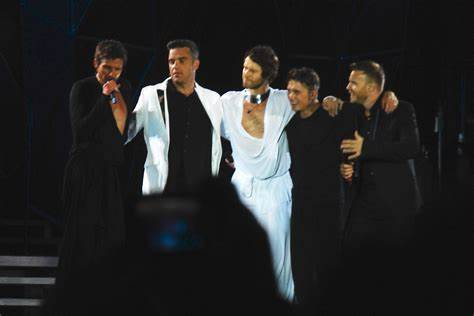Take That: Pop Stardom, Breakups, and Reunions

Take That, the British pop phenomenon, has captivated audiences for over three decades with their catchy melodies, synchronized dance routines, and undeniable charisma. Their story is one of meteoric rise, heartbreaking disbandment, and a triumphant return that solidified their status as one of the UK’s most beloved boy bands. This article delves into the intricate history of Take That, exploring their formation, their peak years, the split that shocked millions, and the subsequent reunions that have cemented their legacy.
From Manchester to the World: The Formation of Take That
The story of Take That begins in Manchester, England, in the late 1980s. Nigel Martin-Smith, a music manager, envisioned creating a British version of the then-popular American boy band New Kids on the Block. His search for talent led him to Gary Barlow, a gifted singer-songwriter who had been performing in clubs since his teenage years. Barlow became the first member of the group, and he played a crucial role in shaping their musical direction.
The lineup was completed with the addition of Robbie Williams, Mark Owen, Howard Donald, and Jason Orange. Every member contributed a distinct personality and skill to the team. Gary Barlow’s songwriting prowess formed the backbone of their music, while Robbie Williams’ rebellious charm and Mark Owen’s boyish appeal captured the hearts of teenage fans. Howard Donald’s dance skills and Jason Orange’s quiet charisma added further dimensions to the group’s dynamic.
Initially, the group performed covers of popular songs, honing their stage presence and developing their synchronized dance routines. They gradually began incorporating original material written by Gary Barlow, which proved to be a turning point in their career.
The Rise to Fame: Chart Toppers and Mania
Take That’s breakthrough came in the early 1990s with a string of hit singles that propelled them to the top of the UK charts. Songs like “It Only Takes a Minute,” “Could It Be Magic,” and “Pray” became instant classics, showcasing their catchy melodies, harmonious vocals, and polished performances.
The band’s popularity exploded, triggering a phenomenon known as “Take That mania.” They became the subject of intense media attention, with their every move scrutinized by tabloids and teen magazines. Their concerts were met with frenzied crowds of screaming fans, and their merchandise flew off the shelves. Take That became a cultural phenomenon, defining the sound of British pop in the early 1990s.
Their success extended beyond the UK, with their music gaining popularity in Europe, Asia, and Australia. They achieved international recognition, solidifying their status as a global pop force. Albums like Take That & Party, Everything Changes, and Nobody Else became multi-platinum successes, further cementing their dominance on the charts.
The Shocking Split: A Nation Mourns
At the height of their fame, in 1995, Robbie Williams left the group, citing creative differences and personal struggles. His departure sent shockwaves through the band’s fanbase and marked the beginning of the end for the original lineup.
Despite continuing as a four-piece for a short time, Take That announced their official disbandment in 1996. The news was met with widespread grief, with many fans feeling a deep sense of loss. The band’s final concert, broadcast live on television, drew massive viewership and became a symbolic end to an era.
The split was attributed to various factors, including the pressure of constant touring and media attention, as well as internal tensions within the group. The members pursued solo careers, with varying degrees of success. Robbie Williams achieved massive solo stardom, while Gary Barlow also embarked on a solo career, though initially with less commercial success than Robbie.
The Triumphant Return: A Reunion for the Ages
In 2005, after years of speculation and rumors, Take That announced their reunion. The original four members – Gary Barlow, Mark Owen, Howard Donald, and Jason Orange – reunited for a documentary and a subsequent tour. The response from fans was overwhelming, with tickets selling out in record time.
The reunion proved to be a resounding success, demonstrating the enduring appeal of Take That’s music and their connection with their fans. They released a new album, Beautiful World, in 2006, which spawned hit singles like “Patience” and “Shine.” The album became a massive commercial success, re-establishing Take That as a major force in the music industry.
The reunion was not just a nostalgic trip down memory lane; it marked a new chapter in Take That’s story. They evolved their sound, incorporating more mature themes and musical styles, while still retaining the core elements that had made them so popular in the first place.

The Five-Piece Reunion and Further Evolution
In 2010, the band announced another exciting development: Robbie Williams was rejoining the group. The original five members reunited for the first time in 15 years, much to the delight of fans worldwide.
The reunited five-piece released the album Progress in 2010, which became one of the fastest-selling albums of the 21st century in the UK. The accompanying tour was a massive spectacle, showcasing the band’s impressive stage presence and their extensive back catalog.
However, this five-piece reunion was not to last. Robbie Williams left the band again in 2012 to focus on his solo career, and Jason Orange departed in 2014, stating that he no longer wished to be part of the band.
FAQs
Who is Take That?
Take That is a British boy band that formed in 1990. The group originally consisted of Gary Barlow, Robbie Williams, Mark Owen, Jason Orange, and Howard Donald. Over time, the lineup has seen changes, with Robbie Williams leaving in 1995 and returning in 2010. Take That is known for their catchy pop hits, energetic performances, and harmonious vocals. They gained immense popularity during the 1990s and continue to be one of the UK’s most successful music acts.
What are some of Take That’s biggest hits?
Take That has produced a number of iconic songs that have become pop classics. Some of their biggest hits include “Back for Good,” “Never Forget,” “Pray,” “Shine,” and “Rule the World.” These songs have charted highly in the UK and beyond, solidifying the band’s place in pop music history. “Back for Good” remains one of their most well-known tracks, with its heartfelt lyrics and enduring popularity.
Why did Robbie Williams leave Take That?
Robbie Williams left Take That in 1995 at the height of their success. The decision was reportedly driven by his desire for a solo career and growing tensions within the band. His departure marked a pivotal moment in Take That’s history, leading to a period of relative quiet for the group. Despite his exit, Williams and the band maintained a strong connection, and he rejoined the group in 2010 for a highly anticipated reunion.
In summary
Take That’s journey has been a rollercoaster ride of highs and lows, but their impact on pop music is undeniable. From their early days as a manufactured boy band to their current status as a respected trio, they have consistently delivered catchy melodies, polished performances, and a strong connection with their fans.
Their story is a testament to the enduring power of pop music and the ability of artists to reinvent themselves and remain relevant over time. Take That’s legacy is secure, and their music will continue to be enjoyed by generations to come. They have cemented their place as one of the UK’s most beloved and enduring pop acts, a testament to their talent, their resilience, and their enduring connection with their audience. They are more than just a band; they are a cultural phenomenon that has shaped the landscape of British pop music.
To read more, Click here



Leave a Comment